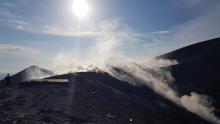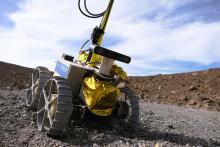It can operate in extreme environments, where toxic gases escape or dangerous munitions are hidden in the ground. Its name is MARVIN - a compact, half-metre-long robot with four grey, coarse-treaded wheels and structures partially protected with gold foil. Equipped with cameras, MARVIN is a newly developed measuring system from the Institute of Geophysics and Geoinformatics at TUBAF, in collaboration with the Chair of Software Technology and Robotics at the Institute of Computer Science and Neurospace GmbH Berlin. This summer, the robot investigated the active volcanic crater "La Fossa" on the island of Vulcano off the north coast of Sicily.
"A test run between boulders and close to the fumaroles, which are cracks or small fissures through which hot and toxic volcanic gases escape from the Earth's interior," explains Dr Jana Börner from the Institute of Geophysics and Geoinformatics at TUBAF. "With the data collected by MARVIN on the local geomagnetic field combined with its position, orientation and inclination, we are preparing a feasibility study. We aim to lay the foundation for future research by developing methods to autonomously collect high-resolution geophysical data and enable the real-time exploration of physical parameters in the near-surface subsurface." Börner is supervising a student thesis, which is due to be published in autumn and will evaluate the measurement results from Vulcano.
Three partners, one goal
MARVIN brings together the expertise of three partners: In addition to Jana Börner's team, robotics professor Sebastian Zug is also working on the project. The researchers equipped the robot with components for navigation, positioning in space and scanning its environment. MARVIN also received magnetometers that measure the Earth's magnetic field with high precision, enabling it to map magnetically active rocks underground. The Berlin-based company Neurospace supplied the rover platform, the travelling base of the robot.
MARVIN on the moon?
On the motivation to develop a measurement system like MARVIN, Jana Börner says: "MARVIN closes the gap between humans and drones when it comes to exploring places like the Fossa crater. In this hostile area, we geophysicists cannot safely explore the ground. Drones, on the other hand, would not provide a sufficiently good resolution for near-surface work. To take geophysical measurements here, we need a robot." MARVIN can be used not only in volcanic areas, but generally in hostile environments on Earth and even in extraterrestrial habitats in the future. Its next area of application? Probably not the moon yet, but MARVIN will soon be deployed underground and in fumarole fields with high concentrations of toxic gases.


